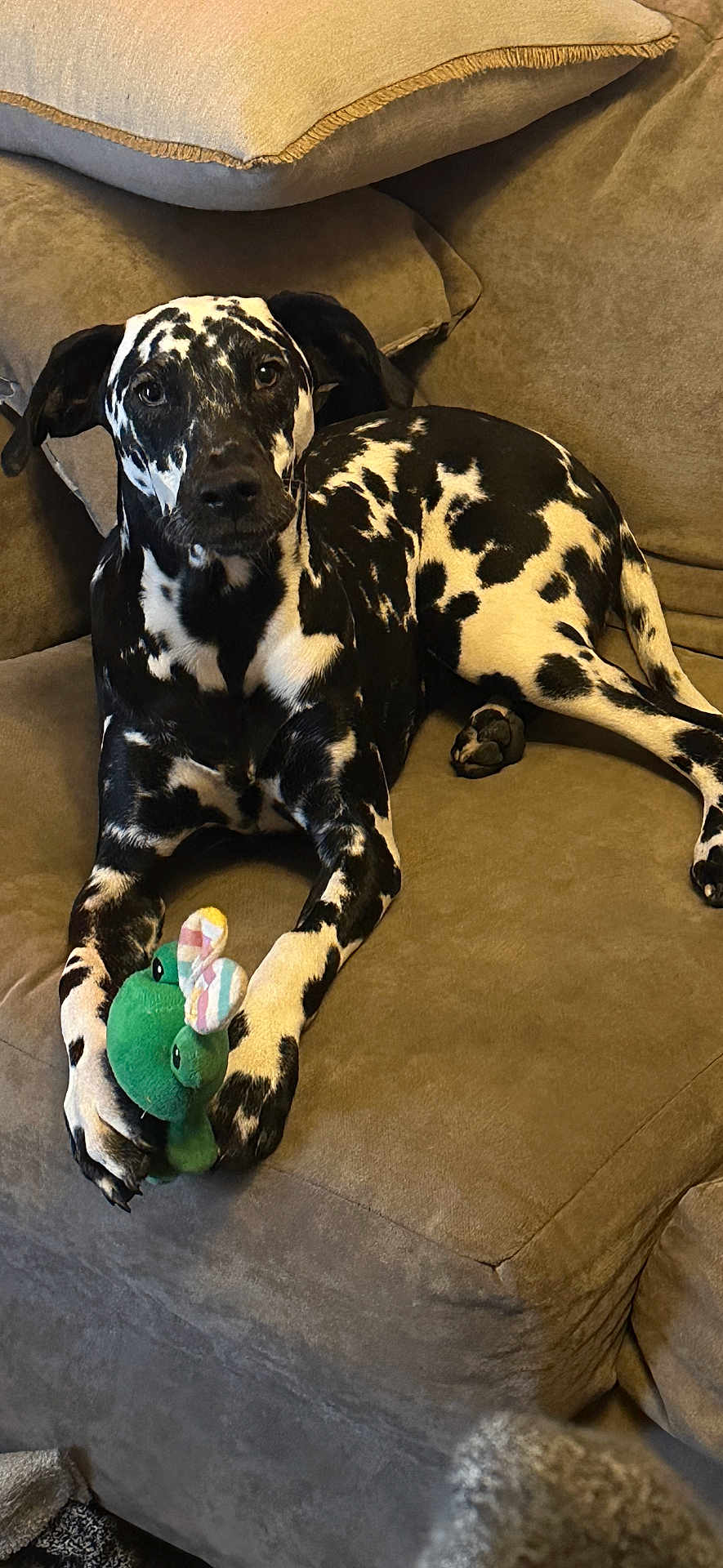
"The history of the Dalmatian breed is as bumpy and spotted as their famous fur, dating back to ancient oeuvrings where they've been depicted alongside horses and carriages, aristocratic companions in medieval Croatia. This storied background makes Dalmatians a fascinating entry into the diverse world of dog breeds, each with its unique attributes and significance."
Personality and Behavior of the Dalmatian
Dalmatians are renowned for their energetic and playful nature. This breed is often described as highly spirited, making them excellent companions for active families or individuals who enjoy outdoor activities. Their history as carriage dogs has endowed them with a considerable stamina and love for long walks or runs.
These dogs are also known for their intelligence and independent mindset. While they can be highly trainable due to their sharp minds, they sometimes exhibit a stubborn streak, requiring a consistent and patient approach to training. Socially, Dalmatians are generally friendly and outgoing, though early socialization is crucial as they can also display protective behaviors towards their family.
In terms of temperament, Dalmatians can be exceptionally loyal and loving to their owners. They are often very good with children, making them suitable for families. However, they are known to be a bit reserved around strangers until they feel comfortable, a trait that harks back to their roles as guard dogs.
Their playful and sometimes quirky behavior can be a source of entertainment as well as bonding. Dalmatians are known to 'smile,' showing their teeth in a playful gesture, which often endears them to both owners and those they meet.
An interesting tidbit about Dalmatians is their surprising affinity with horses. Historically, Dalmatians were used as carriage dogs, running alongside or under the carriage, and they developed a unique bond with the horses they worked with.
Meanings, History and Origins of the name Dalmatian
The name 'Dalmatian' is derived from Dalmatia, a historical region in present-day Croatia. This area is noted in antiquity for its diverse cultural and historical impacts, which reflect the breed’s rich and varied heritage.
The Dalmatian breed's origins can be traced back several centuries, with depictions resembling Dalmatians found in ancient Egyptian artifacts, suggesting their ancestral lineage might be quite ancient. However, it was in Europe, particularly within Dalmatia, where the breed was refined and put to various practical uses, from guard dogs and shepherds to carriage dogs.
Throughout history, Dalmatians have been unique in their roles. In the 18th century, they were employed as carriage dogs, not just running alongside carriages but also providing a protective presence against possible thieves. Their distinctive spotted appearance made them easily recognizable and, therefore, a popular choice for this role.
In the United States, Dalmatians have become iconic as firehouse mascots. This tradition dates back to when horse-drawn fire engines were used, and Dalmatians would run ahead of the engines to clear the path and guide the horses quickly to the fires.
Popularity of the Dalmatian
Dalmatians have enjoyed fluctuating levels of popularity over the years. In certain periods, their unique appearance and spurts of media attention have caused a significant surge in ownership. The most notable instance of this is following the release of Disney’s "101 Dalmatians" and its subsequent adaptations, which led to a massive increase in Dalmatian puppies being adopted.
In speaking countries like the United States and the United Kingdom, Dalmatians have maintained a solid presence among popular dog breeds. The distinct aesthetic appeal of their coat and their dynamic personalities contribute to their sustained desirability.
Globally, Dalmatians are less common than some of the other widely recognized breeds, but they still maintain a token of popularity. In nations like France, Dalmatia (modern-day Croatia), and Scandinavian countries, the breed’s exotic history and elegant look keep them in the selective eye of dog lovers and breeders.
Health and Care of the Dalmatian
Dalmatians are generally healthy dogs, but they do have specific health issues that potential owners should be aware of. One of the most common health problems in Dalmatians is deafness. Around 30% of Dalmatians are affected by some degree of hearing loss due to a genetic trait associated with their distinctive spots.
Another issue prevalent in the breed is urinary stones due to high levels of uric acid. To manage this, a specialized diet low in purines is necessary. Regular vet check-ups and staying vigilant for signs of urinary distress are crucial for maintaining their health.
Grooming a Dalmatian is relatively straightforward but does require consistent effort. Their short coats shed regularly, so brushing a few times a week can help manage shedding and keep their coat healthy.
Due to their energetic nature, Dalmatians need regular exercise—more than just a quick walk around the block. Vigorous daily activities, such as running or interactive play sessions, can help keep them physically and mentally stimulated.
Training and Education of the Dalmatian
Training a Dalmatian can be a rewarding yet challenging endeavor. Their intelligent and at times independent nature means they respond well to positive reinforcement techniques such as treats, praise, and play.
Consistency in training is paramount. Starting with basic obedience training young can set a strong foundation for more advanced commands and tricks later. Socialization during puppyhood is also crucial—exposing them to various people, environments, and other animals can help curb any potential protective or aggressive behaviors.
One common training challenge with Dalmatians is their propensity for stubbornness. This can be mitigated by keeping training sessions short and engaging to prevent boredom. Ensuring that training is fun and part of daily routines can help instill good behavior.
When it comes to house training, Dalmatians generally learn quickly but may have occasional hiccups due to their independent streak. Patience and positive reinforcement are key here too.
Choosing the right breed of dog is a complex decision that hinges on various factors, including lifestyle, activity levels, family dynamics, and personal preferences. For those who enjoy an active lifestyle and seek a dog with a playful and protective nature, the Dalmatian could be an excellent match. Not only do they bring a rich history and unique aesthetic appeal, but their loyalty and spirited presence can make them cherished companions for life.
The Dalmatian's lasting significance in the diverse world of dog breeds is clear—each spot tells a story of historical companionship and modern-day affections. At KingPet contests, we often see numerous Dalmatian participants, showcasing their vibrant personalities and charm. Choosing a Dalmatian can bring not just a beautiful, spotted friend into your life, but also a piece of intriguing canine legacy.
















































































































